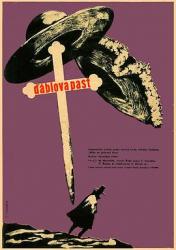1962捷克斯洛伐克7.6分剧情《魔鬼的陷阱》

《魔鬼的陷阱》介绍
名称:魔鬼的陷阱
别名:The Devil's Trap
主演:Karla·Chadimová / 约瑟夫·赫利诺马兹 / Vítezslav·Vejrazka / 米罗斯拉夫·马哈切克 / Jirina·Bílá / Ladislav·Kazda / Frantisek·Kovárík / Cestmír·Randa / Jirí·Belohoubek / Monika·Indingerová / Vlastimil·Hasek / 雅罗斯拉夫·毛奇卡 / 贝德里奇·卡兰 / 伊里·弗斯塔拉 / Vít·Olmer / Milan·Kindl
导演:法兰提塞·维拉席
地区:捷克斯洛伐克
年份:1962
语言:捷克语
时长:85分钟
分类:剧情片
《魔鬼的陷阱》剧情介绍
In the time of Counter-Reformation, a miller and his son come under investigation by a priest of the Inquisition, when rumors spread that their prosperity comes from working with the Devil. The Devil's Trap is a film directed by František Vlá?il, based on a novel by Alfréd Technik, adapted by František A. Dvorák and Miloš Kratochvíl. It was the first of three historical dramas that Vlá?il made during the Czech New Wave (technically he isn't really a part of the New Wave, however these films were made during the same era of artistic freedom), preceding his more well known Marketa Lazarová (1967) and Valley of the Bees (1968). Set in the late 16th Century during the Catholic Reformation, in the Moravian Karst, situated in what is now the Eastern Czech Republic, it tells the tale of a miller (Vítezslav Vejrazka), and his son Jan (Vít Olmer), who come under suspicion and are investigated by a Jesuit priest of the Inquisition (Miroslav Macháchek), when rumors of witchcraft are spread by the local regent (Cestmír Randa), who is jealous of the miller's prosperity and degree of respect among the local populace. As expected from Vlá?il, this film is a stunning experience all the way through. From the opening shot, an ominous manipulation of perspective with a close up of a mangled figure of Christ dominating the foreground against a tiny figure in black walking along the horizon, to the breathtaking confrontational finale inside the vast stalactite filled Karst caverns, it is a wonderful display of visual mastery. Maybe not quite as impressive as Marketa Lazarová, but still full of astonishing imagery. As seen from unique angles and distinct points of view which highlight the director's remarkable sense of awareness of framing, motion, and positioning on the emotional and dramatic tone of the scene. The most memorable being a repeated shot where the camera is suspended and launched with speed through the air towards the miller's door. The story here is a simple one and I would say more accessible than his later works. With a conventional structure emphasized as much by its plot and characters, than by its expressionistic cinematography or authentic historical detail. The events play out without much surprise, and there is a strong underlying, almost supernatural, mysterious aspect that is left unresolved, in fact barely explored, which is slightly disappointing, but only because it's so fascinating that I wish there was more. Acting is great all around. Particularly the villains: Miroslav Macháchek as the priest, casting a sinister and imposing shadow wherever he goes, and Cestmír Randa as the weasel like regent behind all the persecution. While Vít Olmer brings a charismatic leading man presence in his role as the miller's son Jan, in love with the lovely orphan girl Martina (Karla Chadimová), who becomes a dangerous object of rivalry between Jan and other young men of the village. The film also features the evocative music of Zden?k Liška (perhaps the most prolific composer of the Czech New Wave). In this his second of eleven collaborations with Vlá?il, his compositions are used sparingly, but to great effect, complimenting but never overpowering a scene. The best example of which can be heard in an amazingly shot celebration and dance sequence at the end of the second act. The Devil's Trap might not be a masterpiece, but it is still a strong effort, with a fascinating straightforward story and a glorious historical setting captured beautifully by Vlá?il's unmistakable visual prowess. A fine work that would also be the perfect starter plate to prepare yourself for the challenging feast of Marketa Lazarová or The Valley of the Bees. It even has an easy to digest running time. It's therefore puzzling why this gem remains largely overlooked and ignored.《魔鬼的陷阱》豆瓣热评
极具个人形式美感的摄影构图,黑白的静止场景一如油画般精致。诡异的静谧镜头与沉默压抑的角色,使电影凸显阴暗的质感。人性与信仰,爱情与宗教,花与白十字,极权与智慧的较量;预感灾难的情节设置延续至「蜂之山谷」。
7.2;可能是片長比較短,這部看著沒那麼煩人了,空間的層次張力倒是十分吸引人
从片名来看好似恐怖甚至是奇幻的类型,但是剧情却踏踏实实围绕在平民和政权、宗教三方之间,做一番讽刺现实中的魔鬼的闹剧。被污蔑的被谣言宣称和魔鬼有染的磨坊主及其儿子,只是一心一意挖掘水源辛苦劳作。而一心想要致人于死地的宗教领袖代表和政权代表沆瀣一气,致力于宣扬谣言,将人民打到,攻击他们为恶魔。实在是做贼喊抓贼的一出好戏。文本利用奇幻的元素来讽刺、抨击特权阶层,影片甚至没有出现什么鬼怪恶魔,却已经将恶魔真正的面目描写得非常具体。
对权力、地位的盲目崇拜才是真正的魔鬼的陷阱,莫须有的责难和罪过是人类内心的邪恶。3.5
海报画得很好,世权和神权拼成的十字像把利刃悬在人们上方,剑锋直面着走在追求爱与自由的男女。分镜与调度在告诉大家,究竟谁是恶魔谁是上帝;教会和贵族垄断着水源和土地,草地的群羊嗷嗷待哺,只能看着空荡荡的深渊沉默。
反正我有啥说啥,说错了就说错了。尽管运镜和剪辑确实迷人,但这电影让我极度迷惑,明明是个叙事性挺强的电影,我怎么捯回去看都看不明白,基本靠猜,不知道是电影本身的问题还是字幕的问题。给我的感觉不单是前言不搭后语、不符合正常人类的沟通思维,而且许多关键信息是怎么给出的我完全接收不到——包括但不限于谣言是啥、牧师来干啥的、故事背景是个什么设定、老爸去哪了甚至每个人物之间的关系......对了,还有就是牧师往什么地狱之门里头扔石头为什么可以扔那么远?地下湖边有个人,他是谁,在那干啥呢?我也是极为困惑。总结来说就是很浪费感情。
没有暗黑的恶魔与巢穴,只有心中的嫉妒和污蔑,有云:相由心生,魔亦由心生。往下未必就是地狱,向上也不一定通往天堂,所谓“魔鬼的陷阱”,是对上帝盲信盲从者一记犀利的愚弄。
老塔有借鉴吗?这声音处理和空间指涉真超前
罕见的,一部可以有魔鬼,但是不需要上帝的电影。
如果你不费劲的爱他,你就根本不会爱他。
8.0 恶魔的眼睛化为摄像机,使得它无处不在,人物的眼睛跟随着摄像机,恶魔早已遍布人心,远处的鸟叫在试图证明伊甸的存在,神说要往上初看,牛向地下看,恶魔早已按照神谕补下陷阱,救赎之路通向地下
7.5。观影最大困惑是,观影后看豆瓣发现很多人说没看懂剧情在说什么。我不由得困惑了这些人想看懂到什么程度
非常漂亮。这样的电影拍摄于各地新浪潮逐渐涌现的时期,想来蛮有意思
宗教的愚蠢和对科学的迫害就是自身创造出的魔鬼陷阱。
摄影是顶级的,有点老塔的范儿,但主题确实是让俺迷惑,有个运动镜头还挺牛的
捷克新浪潮局外人的中世纪三部曲之一,波西米亚村庄的异教审判,还没有接下来的巨制Marketa Lazarova那么maximalist,故事也直白得多,但其诡异压迫的超自然氛围依然达到了弥漫围裹的四维效果,尤其是几段仿佛灵魂出窍的POV和如影随形的音效配乐。画面里人物与建筑、自然的位置关系匠心独运,随处都是孕育意象的死物(水罐、蜡烛、大镰刀……)。天由天主教垄断,和地说话的人一定是中了邪。几百年过去了,越来越多的人相信科学是歪理邪说,没有更毛骨悚然的了。
并没有“魔鬼的陷阱”,比起来自然界的溶洞地质构造,嫉妒、怀疑、构陷更易使人心入魔,成为人性和道德陷阱。信仰沦为强权的奴隶,发酵膨胀的还是利益争夺和权力欲。磨坊主以事实为依据,找到事物发展变化之理,对贵族教会的愚民策略和大众盲目的信仰猛刺一击,这无形的讽刺使得宗教裁判调查必定丧失公允。影片意象象征意义强烈,运镜牛B,镜头所到之处,开合纵横,气势夺目。视角变换丰富,构图精致凝炼。与法兰提赛的《乱世英豪》、《蜂之谷》相比,形式与内涵融合度略差,有一种形式至上的过度感。
基督教题材影片。不同于法兰提赛的《蜂之山谷》,影片中的磨坊主用自己的良心对当时的伪善的基督教展开了猛烈的进攻。等级森严的封建社会下必然容不下如此“魔鬼”,因此宗教代表牧师要杀死磨坊主,以儆效尤。但是究竟谁是魔鬼?法兰提赛用构图与光影告诉了观众。当牧师与领主谈话时,法兰提赛将牧师置于背景,光透过监狱般的窗户投向牧师,明暗对比强烈,暗示了牧师的身份。另外,马丁娜在祈祷室忏悔时,摄影机以俯视视角拍摄人物,且将硬光投射在其身上,渲染了宗教的庄严性肃穆感以及压迫感。三次的摄影机以正对磨坊门的轴线运动也是一大特色,骑马的主观视角,暗示了牧师领主的权力及最后的死亡命运。黑白画面下,每一个角色的脸部表情都如雕塑般精雕细琢,如同油画般精致,一种神秘的不可言说的氛围油然而生。
信仰是强权的傀儡,这个牧师的形象有点像阿基尔上帝的愤怒里的牧师
神父不一定是圣徒,很可能是魔鬼。当权力、嫉妒、欲望、控制占领心灵,他就走向了魔鬼的洞穴,走向覆灭。法兰提塞·维拉席的电影注重形式创新,片中模仿镰刀割麦子的镜头与《我是古巴》里割甘蔗的镜头神似;三个由远及近的长镜头,渲染战争、神权等外力对于人的压迫。
所谓的魔鬼的陷阱,指向好像不存在,但又存在的大他者
在反宗教改革时期,一个磨坊主和他的儿子受到宗教裁判所牧师的调查,因为有谣言说他们的成功来自与魔鬼的合作。《魔鬼陷阱》由弗兰迪 · 克拉伊尔执导,根据阿尔弗雷德 · 科尼克的小说改编,由弗兰迪 · 克 · 德沃拉克和米洛 · 克拉托克维尔改编。这是瓦拉伊尔在捷克新浪潮时期制作的三部历史剧中的第一部(严格来说,他并不是新浪潮的一部分,但是这些电影是在艺术自由的同一时期制作的) ,在他更著名的《玛卡塔 · 拉扎洛娃》(1967)和《蜜蜂谷》(1968)之前。故事发生在16世纪晚期的天主教改革时期,摩拉维亚喀斯特地区,位于现在的捷克共和国东部,讲述了一个米勒(维特兹拉夫 · 维耶拉兹卡)和他的儿子扬(维特兹拉夫 · 奥尔默)的故事,他们受到怀疑,被宗教裁判所的一名耶稣会牧师(米罗斯拉夫 · 马查切克
借着宗教的名义肆意审判他人,画面与音乐的烘托之下电影很压抑,但是翻译比较糟糕导致看起来还是有点痛苦的
依旧围绕着信仰与宗教 叙事性蛮强 但还是有点沉闷无聊 困意十足 dbq是我高估了自己…
空间好看,魔鬼借pov生出的存在感这个质感很独特
纯粹关于宗教的故事自然隐喻多的不得了,人脸认不清
As reflection of Vlácil thought; the ruler neglect to admit the true nature existence instead, rigid dichotomy between science and mysticism
本文采摘于网络,不代表本站立场,转载注明出处:https://www.gouzhua33.com/jianjie/5290320243/17116969454456.html
